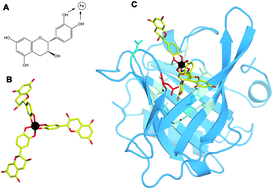当前位置:
X-MOL 学术
›
Metallomics
›
论文详情
Our official English website, www.x-mol.net, welcomes your
feedback! (Note: you will need to create a separate account there.)
Linking iron-deficiency with allergy: role of molecular allergens and the microbiome
Metallomics ( IF 2.9 ) Pub Date : 2017-11-09 00:00:00 , DOI: 10.1039/c7mt00241f Franziska Roth-Walter 1, 2, 3, 4, 5 , Luis F. Pacios 6, 7, 8, 9, 10 , Rodolfo Bianchini 1, 2, 3, 4, 5 , Erika Jensen-Jarolim 1, 2, 3, 4, 5
Metallomics ( IF 2.9 ) Pub Date : 2017-11-09 00:00:00 , DOI: 10.1039/c7mt00241f Franziska Roth-Walter 1, 2, 3, 4, 5 , Luis F. Pacios 6, 7, 8, 9, 10 , Rodolfo Bianchini 1, 2, 3, 4, 5 , Erika Jensen-Jarolim 1, 2, 3, 4, 5
Affiliation

|
Atopic individuals tend to develop a Th2 dominant immune response, resulting in hyperresponsiveness to harmless antigens, termed allergens. In the last decade, epidemiological studies have emerged that connected allergy with a deficient iron-status. Immune activation under iron-deficient conditions results in the expansion of Th2-, but not Th1 cells, can induce class-switching in B-cells and hampers the proper activation of M2, but not M1 macrophages. Moreover, many allergens, in particular with the lipocalin and lipocalin-like folds, seem to be capable of binding iron indirectly via siderophores harboring catechol moieties. The resulting locally restricted iron-deficiency may then lead during immune activation to the generation of Th2-cells and thus prepare for allergic sensitization. Moreover, iron-chelators seem to also influence clinical reactivity: mast cells accumulate iron before degranulation and seem to respond differently depending on the type of the encountered siderophore. Whereas deferoxamine triggers degranulation of connective tissue-type mast cells, catechol-based siderophores reduce activation and degranulation and improve clinical symptoms. Considering the complex interplay of iron, siderophores and immune molecules, it remains to be determined whether iron-deficiencies are the cause or the result of allergy.
中文翻译:

将铁缺乏症与过敏联系起来:分子过敏原和微生物组的作用
特应性个体倾向于产生Th2显性免疫反应,导致对称为过敏原的无害抗原过敏。在过去的十年中,流行病学研究已经出现,这些研究将过敏与铁缺乏状态联系在一起。缺铁条件下的免疫激活导致Th2细胞(而非Th1细胞)扩增,可诱导B细胞的类别转换,并阻碍M2而不是M1巨噬细胞的正确激活。此外,许多变应原,特别是具有脂钙蛋白和脂钙蛋白样褶皱的变应原,似乎能够通过以下方式间接结合铁邻苯二酚含有邻苯二酚部分。然后,在免疫激活过程中,导致的局部限制性铁缺乏症可能导致Th2-细胞的生成,从而为过敏性致敏做好准备。此外,铁螯合剂似乎也影响临床反应性:肥大细胞在脱粒之前会积聚铁,并且根据遇到的铁载体的类型似乎会有不同的反应。去铁胺可引起结缔组织型肥大细胞脱颗粒,而基于儿茶酚的铁载体可减少活化和脱颗粒并改善临床症状。考虑到铁,铁载体和免疫分子之间的复杂相互作用,铁缺乏是过敏的原因还是结果仍有待确定。
更新日期:2017-11-09
中文翻译:

将铁缺乏症与过敏联系起来:分子过敏原和微生物组的作用
特应性个体倾向于产生Th2显性免疫反应,导致对称为过敏原的无害抗原过敏。在过去的十年中,流行病学研究已经出现,这些研究将过敏与铁缺乏状态联系在一起。缺铁条件下的免疫激活导致Th2细胞(而非Th1细胞)扩增,可诱导B细胞的类别转换,并阻碍M2而不是M1巨噬细胞的正确激活。此外,许多变应原,特别是具有脂钙蛋白和脂钙蛋白样褶皱的变应原,似乎能够通过以下方式间接结合铁邻苯二酚含有邻苯二酚部分。然后,在免疫激活过程中,导致的局部限制性铁缺乏症可能导致Th2-细胞的生成,从而为过敏性致敏做好准备。此外,铁螯合剂似乎也影响临床反应性:肥大细胞在脱粒之前会积聚铁,并且根据遇到的铁载体的类型似乎会有不同的反应。去铁胺可引起结缔组织型肥大细胞脱颗粒,而基于儿茶酚的铁载体可减少活化和脱颗粒并改善临床症状。考虑到铁,铁载体和免疫分子之间的复杂相互作用,铁缺乏是过敏的原因还是结果仍有待确定。











































 京公网安备 11010802027423号
京公网安备 11010802027423号